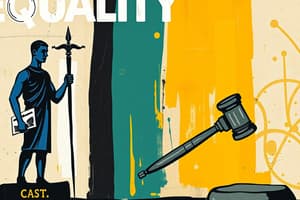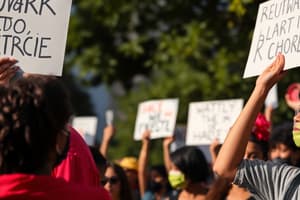Podcast
Questions and Answers
Explain how the concept of equality has been interpreted and applied differently in Canadian legal and social contexts over time, referencing specific movements or historical events.
Explain how the concept of equality has been interpreted and applied differently in Canadian legal and social contexts over time, referencing specific movements or historical events.
Historically, equality was often viewed through a formal lens, emphasizing equal treatment under the law. Over time, the focus has shifted towards substantive equality, recognizing that historical and systemic inequalities require proactive measures to ensure equitable outcomes. Movements like BLM and Indigenous rights movements highlight the ongoing struggle for substantive equality.
Differentiate between 'formal equality' and 'equality of outcome,' and provide an example of a policy or law that might appear to promote formal equality but could lead to inequality of outcome.
Differentiate between 'formal equality' and 'equality of outcome,' and provide an example of a policy or law that might appear to promote formal equality but could lead to inequality of outcome.
Formal equality focuses on equal treatment and removing barriers, while equality of outcome aims for similar results. A seemingly neutral policy like standardized testing can create inequality of outcome due to unequal access to resources needed for success.
Describe the central holding of Levell and Bedard (1973), and summarize the concept of equality it reflects. How does this relate to Aristotle's views on equality?
Describe the central holding of Levell and Bedard (1973), and summarize the concept of equality it reflects. How does this relate to Aristotle's views on equality?
Levell and Bedard upheld a law that treated Indian women differently from Indian men regarding status, and didn't view it as discrimination. This reflects a formal equality approach, treating similar groups the same way, but not necessarily inter-group. Aristotle believed that likes should be treated alike and unlikes differently.
Contrast individual vs. collective approaches to addressing discrimination. What are the main differences in their focus and remedies?
Contrast individual vs. collective approaches to addressing discrimination. What are the main differences in their focus and remedies?
Give an example of an unintentional rule or policy that is neutral on the surface but reinforces existing inequalities. How can standardized tests perpetuate discrimination?
Give an example of an unintentional rule or policy that is neutral on the surface but reinforces existing inequalities. How can standardized tests perpetuate discrimination?
Summarize the arguments for and against using affirmative action to address inequalities.
Summarize the arguments for and against using affirmative action to address inequalities.
Briefly describe the significance of the Andrews v. Law Society of British Columbia case in Canadian equality law.
Briefly describe the significance of the Andrews v. Law Society of British Columbia case in Canadian equality law.
According to the Kapp (2008) ruling, what must discrimination entail to be deemed truly dicriminatory under s.15.?
According to the Kapp (2008) ruling, what must discrimination entail to be deemed truly dicriminatory under s.15.?
Explain the difference between "enumerated" and "analogous" grounds of discrimination under Section 15 of the Charter.
Explain the difference between "enumerated" and "analogous" grounds of discrimination under Section 15 of the Charter.
How do courts determine whether a distinction is discriminatory, considering Section 15(2) of the Charter, which protects affirmative action programs?
How do courts determine whether a distinction is discriminatory, considering Section 15(2) of the Charter, which protects affirmative action programs?
Describe the key components of the Royal Proclamation of 1763 and its significance in the context of Indigenous rights in Canada. How did the colonists react to it?
Describe the key components of the Royal Proclamation of 1763 and its significance in the context of Indigenous rights in Canada. How did the colonists react to it?
Explain the concept of the Crown's 'fiduciary duty' to Indigenous peoples, as it relates to the Royal Proclamation of 1763.
Explain the concept of the Crown's 'fiduciary duty' to Indigenous peoples, as it relates to the Royal Proclamation of 1763.
Summarize Section 35 of the Constitution Act, 1982, and explain its importance for Indigenous rights in Canada.
Summarize Section 35 of the Constitution Act, 1982, and explain its importance for Indigenous rights in Canada.
What is the significance of the Sparrow v. The Queen (1990) case in relation to Section 35 of the Constitution Act, 1982?
What is the significance of the Sparrow v. The Queen (1990) case in relation to Section 35 of the Constitution Act, 1982?
Describe the two-step legal test established in Sparrow for determining whether government action that infringes an Aboriginal right is justified.
Describe the two-step legal test established in Sparrow for determining whether government action that infringes an Aboriginal right is justified.
What is the significance of Delgamuukw v. British Columbia (1997) in the context of Aboriginal title, and what three things must an Aboriginal title claim prove?
What is the significance of Delgamuukw v. British Columbia (1997) in the context of Aboriginal title, and what three things must an Aboriginal title claim prove?
Explain Section 7 of the Charter, focusing on the concepts of 'life, liberty, and security of the person.' Provide an example of a case where this section was invoked.
Explain Section 7 of the Charter, focusing on the concepts of 'life, liberty, and security of the person.' Provide an example of a case where this section was invoked.
Outline the Oakes test. What two conditions must be statisfied in order to justify a limitation on a Charter right?
Outline the Oakes test. What two conditions must be statisfied in order to justify a limitation on a Charter right?
How does the 'dialogue theory' explain the relationship between courts and legislatures in protecting rights, and what is the role of Section 33 (the notwithstanding clause) in this context?
How does the 'dialogue theory' explain the relationship between courts and legislatures in protecting rights, and what is the role of Section 33 (the notwithstanding clause) in this context?
What is 'coordinate construction', and why is it especially pertinent for s. 7 rights and the Oakes test in Canada?
What is 'coordinate construction', and why is it especially pertinent for s. 7 rights and the Oakes test in Canada?
Flashcards
Formal Equality
Formal Equality
Formal equality means equal treatment in law and social status. It aims to remove formal barriers and biases, leading to equal opportunity and, ideally, equality of outcome.
Collective Discrimination Approach
Collective Discrimination Approach
Focuses on correcting systemic disadvantages by ensuring equal access and opportunities for groups historically facing discrimination.
Individual Approach to Discrimination
Individual Approach to Discrimination
An approach where only individuals directly harmed by specific discriminatory acts are entitled to a remedy, provided by the violator within a closed system.
Crown's Fiduciary Duty
Crown's Fiduciary Duty
Signup and view all the flashcards
Treaty Requirement
Treaty Requirement
Signup and view all the flashcards
Aboriginal Rights
Aboriginal Rights
Signup and view all the flashcards
Treaty Rights
Treaty Rights
Signup and view all the flashcards
Section 25 of the Charter
Section 25 of the Charter
Signup and view all the flashcards
Section 35, Constitution Act, 1982
Section 35, Constitution Act, 1982
Signup and view all the flashcards
Oakes Test
Oakes Test
Signup and view all the flashcards
General Remedy Power
General Remedy Power
Signup and view all the flashcards
Reading Down
Reading Down
Signup and view all the flashcards
Air of Reality Standard
Air of Reality Standard
Signup and view all the flashcards
Extreme Drunkenness Defense
Extreme Drunkenness Defense
Signup and view all the flashcards
The right to life, liberty and security of the Person
The right to life, liberty and security of the Person
Signup and view all the flashcards
Study Notes
Equality Rights Overview
- Guarantees that unions can advocate for workers, including actions like government intervention in private sector labor disputes.
- Includes section 15 of the Charter, the 1960 Bill of Rights, Human Rights Acts, Human Rights Codes, and various laws.
- Is vital to the legal system.
- Has a history of inequality.
- This history of inequality is visible in movements, such as Black Lives Matter and Indigenous movements.
Understanding Equality
- The right to equality is a frequently litigated issue, with the Supreme Court struggling to interpret its scope.
- Formal equality involves equal treatment and status in law and society.
- Equal opportunity focuses on removing barriers and biases.
- Equality of outcome aims for substantive equality, ensuring similar results.
- Charter focuses on the effect of policies, even if unintended, and whether they lead to unequal outcomes.
- Aristotle argued likes should be treated alike, and different groups should be treated differently.
- Levell and Bedard (1973) challenged the Indian Act revision, arguing that it discriminated against women, resulting in the court emphasizing equity instead of equality.
Individual vs. Collective Approaches to Discrimination
- Rooted in different conceptions of justice.
- These approaches lead to different demands from the government.
- The individual approach focuses on remedies for individuals harmed by specific discriminatory acts.
- Remedy comes from the perpetrator.
- System is closed.
- Overlooks systemic disadvantages.
- Intentional state design, such as the Lord's Day Act, Indian Act, and Head tax, are examples of systemic disadvantage.
- Africville's displacement in the 1960s exemplifies a systemic disadvantage.
- Unintentional policies, like standardized testing (e.g., LSAT), can be discriminatory due to the financial burden.
- This can create a barrier to poorer applicants.
- Women (single mothers), Indigenous peoples, and Black individuals are disproportionately affected by poverty and disadvantage.
- Systematically disadvantaged in becoming lawyers.
- Not everyone suffers equally.
- Policy is made by many state actors over time.
- Becomes institutionalized in capitalism and attitudes.
- Multiple disadvantages can reinforce each other.
- Discrimination is isolated.
Collective Approach
- Originates from:
- The idea that societal goods should be distributed based on merit.
- The belief in merit being randomly distributed, with every group possessing excellence
- A society lacking this distribution indicates overall disadvantage.
Addressing Disadvantage
- Involves correcting imbalances caused by bias, nepotism, or preference, that cause skewed distribution of merit.
- It also involves improving accessibility to education, experience, and merit markers.
- "Ameliorative treatment" specifically addresses disadvantaged groups.
- A version of this is Affirmative action.
- Aims to level the playing field by targeting aid to disadvantaged groups.
- Section 15(2) protects affirmative action programs.
Criticisms of the Collective Approach
- Under-inclusion: Some individuals outside the targeted group may face similar disadvantages.
- One solution is to broaden the scope of assistance.
- Overbreadth: Disparities within the group exist.
- Some individuals are less disadvantaged than others.
- It may not remove prejudices.
- Remedy concerns: Questions of who bears the burden.
- It may impose burdens on individuals without a direct connection to the discrimination.
- It gets fuzzier.
Section 15 of the Charter
- Has had a substantial policy impact.
- Reshapes the legal landscape.
- Implementation was delayed until 1985.
- Governments did not prepare adequately.
Key Interpretive Questions
- Involves the interpretation of "equal benefit and approach."
- As well as distinctions vs. discrimination.
- Determining whether grounds are exclusive or whether they are grounds you can't discriminate on.
- It also covers whether Advantaged groups can claim equality rights, or if only disadvantaged groups can.
- Court first addresses questions in a 1989 (Andrews from BC) case.
- The case revolved around requiring lawyers to be Canadian which was challenged under s. 15.
- Kapp (2008) establishes main precedent on s. 15.
- Discrimination equates to being disadvantaged.
- Discrimination can cause material harm (money, job) or reflect prejudice.
- Feds could give indigenous bands in BC exclusive fishing rights for 24 hours which was challenged and rejected by other groups as racism.
- It prevents the government from perpetuating group disadvantages and stereotypes.
- Discrimination must be based on merit/capability reasons.
- Bona fide is related to merit
- Includes enumerated and analogous grounds that can't be used to discriminate
Analogous grounds
- Like holistic ones that have been addressed by Andrews
- Biggest case was 1995 which revolved around sexual orientation
- Analogous grounds key characteristics:
- Insular group (unable to participate in politics historically).
- Discrete group (easy to know if you belong to the group)
- Not exclusive to one group, so large groups and small groups (e.g women) can be discriminated against.
- Historically disadvantaged group
- The personal characteristics unrelated to merit, are immutable; one cannot easily change common law (i.e religion, SSM & couples)
Charter Section 15: Subsections 1 and 2
- Section 15(1) includes three declarations and four kinds of equality.
- Everyone is equal and before the law.
- Everyone has the right to equal protection and benefit of the law without discrimination.
- Listed grounds of discrimination include race, color, ethnicity, religion, sex, nationality, age, and mental/physical disability.
- Section 15(2) protects affirmative action programs.
- If a law aligns with affirmative action it is not discrimination.
- A measure intended to address discrimination does not violate s. 15(1) if it aligns with s. 15(2).
- Courts do not acknowledge reverse discrimination; only disadvantaged groups can seek equality rights.
- Equality rights are a source of legal disagreement.
- Systemic adverse claims have been accepted.
- Charter documents are more influential than true.
- Policy such as RCMP's part-time job sharing for women with child responsibilities being denied, was viewed by people to be discriminatory (but court agreed)
Indigenous Rights
- Acknowledge Indigenous heritage ("O Canada, our home on Native land…").
- The relationship between Indigenous and European settlers is complex and tragic.
Indigenous Rights and Sovereignty
- Laws affecting Indigenous peoples have been based on fiction.
- Doctrine of Discovery:
- Assumed Indigenous inferiority.
- Declared terra nullius.
- Granted sovereignty through "discovery."
- Europeans claimed land through companies like the Hudson Bay Company.
- Relied on locals for partnership.
- Sought military alliances with Indigenous peoples.
- Royal Proclamation of 1763 asserted Crown sovereignty.
- Recognized Indigenous rights.
- Mandated fair dealings.
- Required treaties for land transfers.
- Established Crown's fiduciary duty.
- Prevented private land grabs.
- Reserved land acquisition to Crown.
- Treaty of Niagara, 1764, exemplified nation-to-nation approach.
- Negotiated by 24 nations and the Crown.
- Embodied mutual agreements in a wampum belt for peace, trade, and alliance.
- Historically, Indigenous treaties involved exchanges of land for money or goods.
- Treaties became less consensual and more about telling over negotiation as Europeans began taking over the Indigenous lands.
- Indigenous-state relations are defined by historic treaties.
- Including nation-to-nation agreements, mutual benefits, and coexistence, exemplified by the Indian Act of 1876.
- Indian Act of 1876
- It is an act of parliaments
- Asserted power over "Indians"
- Replaced traditional Indigenous leadership with appointed band councils.
- It deemed Indigenous practices illegal.
- Determined who was or was not legally "Indian", stripping Indigenous women of status if they married non-Indigenous men.
- Facilitated residential schooling.
- Assimilated Indigenous peoples, disregarding past treaty agreements.
- Imposed top-down control via formalized reservations without consultation or consent
- Indigenous peoples' rights are addressed in Section 91(24), the Constitution Act of 1867, and Section 35, the Constitution Act of 1982
Indigenous Rights and the Constitution
- Indigenous peoples' rights stemmed from traditional land use.
- Treaty rights were specific, based on treaties or land claim agreements.
- Broader Aboriginal rights were often exchanged for treaty rights.
- Section 25 of the Charter shields Aboriginal/Treaty rights.
- It functions as a permanent, comprehensive notwithstanding clause.
Indigenous Rights
- Vary but are not consistently specified.
- Envisioned self-government early on, later diminished.
- They are either group-collective or group-differentiated.
- Group or collective rights are exercised by a group (e.g., land claims, self-government).
- Rights that are exercised by individuals within a group are group-differentiated (e.g., treaty rights to hunt).
- Indigenous peoples could not take action to make claims in court until 1951
Sparrow v. The Queen (1990)
- Case offers comprehensive view of s. 35.
- It recognizes and affirms existing Aboriginal rights.
- The case deals with the meaning of Existing versus Recognized.
- Extinguished rights stay that way, unextinguished rights will stay protected.
- Pre existing rights must be explicitly explained, and it could not freeze the original meaning (for tech reasons)
- Adverse impact is the first step in the SCC's limitations clause.
- Courts need to make sure governments follow unreasonableness and not impose on the other group.
- Governments need to show that they have compelling legislative objectives.
- Consultation with the group and fair compensation are important.
Aboriginal Title (Calder, 1973)
- The government did not acknowledge or accept the indigenous peoples owning the land.
- Legal ownership of the land has not been extinguished at any point.
- SCC reversed.
- The Aboriginal claim can still continue on prompting land claims.
- These had opposition that lasted til 1990s.
- Delgamuukw v. B.C., 1997 has successfully claimed the title in 2014.
Aboriginal Title Requirements
- Land occupation has to be from contact and it needs to be exclusive + continuous.
- One must be engaging in oral history and consult in order to get a compensation.
- Delgamuukw must be for the inherent right to self-government
- It has been cited in Tsilhqot'in
- VC government has made moves to do first comprehensive treaty, the Nisga'a Treaty from 1998
Studying That Suits You
Use AI to generate personalized quizzes and flashcards to suit your learning preferences.




